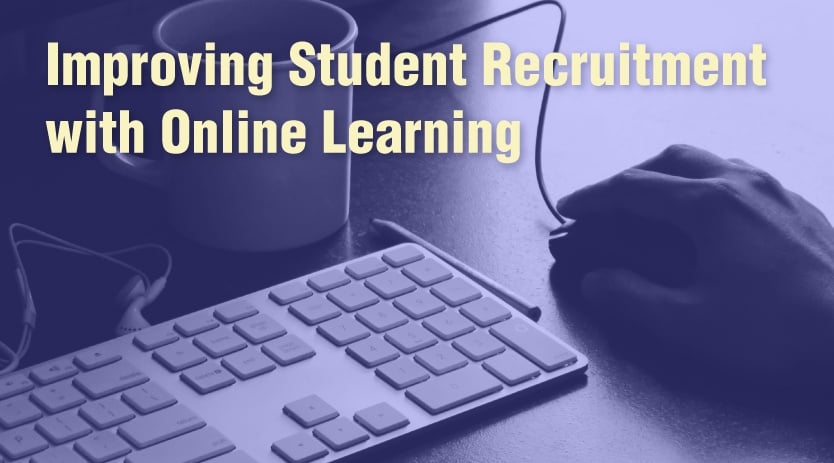The most well-known applications of online learning have been in for-credit courses or MOOCs. As we found in our recently published white paper, opportunities for differentiation exist with both the pre-matriculation and post-graduation applications. A client of ours recently worked with us to design a program for improving student recruitment so I thought I’d use this space to highlight some possibilities for the pre-matriculation stage.
Improving student recruitment has at least two dimensions about which university officials care. The first is to recruit a large number of qualified, interested applicants. They want to be able to report a low yield figure without having to read a lot of uninteresting applications from unqualified applicants who are only marginally interested in the college. The second is to have these students eventually graduate, and this usually requires that the students be both qualified and interested in the experience that the student will actually have at the college. College presidents and enrollment managers are quite motivated to be able to report a high graduation rate, and to do this they have to admit exactly this type of student (i.e., both qualified and interested). In the following I explore opportunities that universities, colleges, and schools (which I will simply refer to as colleges for brevity from here on out) have related to improving student recruitment.
Improving student recruitment option #1: Create a preparatory program
Colleges want accepted applicants to matriculate, but they also want matriculated students to graduate. These two requirements (among many) keep colleges from accepting every applicant. For the first part to occur, many colleges believe that getting applicants involved with the school, with giving them a high quality exposure to the school, will increase their chances of attracting students who are both better and a better fit. For the most part a quality exposure has meant spending more time and effort on marketing materials and campus tours. Online learning provides another approach to the first part (matriculation) while also improving the odds of the second part (graduation) occurring.
For example, every college that I have had contact with is worried about the math preparedness of a significant portion of their incoming classes. Some colleges have their own on-campus preparatory programs but these never have enough capacity to help all of the students who have the need. If the college were to create a quality, engaging, adaptive, competency-based education program that gets students up to speed while showcasing their faculty and staff, this would have the following benefits:
- Applicants would have a better idea of what the college’s faculty are like
- Applicants would have a better idea of the rigor and intellectual demands of college classes
- Applicants (as enrolled students) would be better prepared for their early college classes which, for many if not most institutions, make up the highest-risk period of the college experience — and if the student doesn’t make it through their freshman year, then, by definition, they aren’t going to graduate (not to put too find a point on it)
It's not clear to me that a college should charge for this program or restrict enrollment in it to admitted students. What would be the downside of giving more students exposure to such a program once it has been developed?
Improving student recruitment option #2: Create a summer online experience for juniors or seniors
A college can make a big splash in their pre-matriculation efforts with a summer experience for rising high school juniors or seniors. The college usually focuses the experience on their particular strength, whether it be biology, engineering, marketing, or whatever. The drawback is that the program is only available to the small number of students who can make it to campus and afford the (usually significant) cost of living on campus for the duration of the program. A recent story has shined a light on the fact that colleges might not find these programs, definitely quite expensive in their own right to put on and for students to attend, might not be the resume-builders that students had assumed they were. Well, if they aren’t resume-builders that are worth a students time, students and colleges could still find it worthwhile to attend and produce, respectively, these experiences if they didn’t require such a large cash and time outlay.
An alternative is to create an online experience targeted at that same demographic but that allows an essentially unlimited number of participants. The college should work to incorporate both engaging (and engaged) faculty who are used to presenting to younger students (i.e., introductory college classes) as well as academic life staff who can design appropriate co-curricular experiences. These staff-driven experiences would be, if not unique, a differentiating part of the online experience compared to what is currently in the market (as limited as that sample is). The importance of including staff cannot be overstated — a college experience is composed of life-in-the-classroom plus a much greater proportion of time spent outside the classroom. If a school is able to convey through the online experience an example of the rich kind of co-curricular experience that is offered at the college during the student’s time on campus, then that college would be that much farther ahead in terms of attracting applicants who would thrive and be a good fit for the college.
Improving student recruitment option #3: Create an outreach- and alumni-focused mentoring program
Many colleges have alumni networks that are interested in helping their school attract the best applicants. Many of these colleges employ these alumni as interviewers, hosts of yield events, and information resources for parents and applicants. Certainly these can be good uses of the alumni; however, many alumni have the capability for and interest in doing more. The question has always been to determine how to take advantage of this highly capable and distributed resource.
One new answer that presents itself is a project-based online learning experience that uses alumni as mentors for high school students. The project and alumni dimensions give the experience flexibility. Are the strengths of the school in social causes, or public policy, or entrepreneurship, or great books, or programming, or ... ? A college should be able to design an experience for which a select group of alumni should be qualified to act as online mentors. Faculty could design the program, create some online resources and background material, and then staff professionals and the alumni mentors could carry the experience forward. Potential applicants would get exposure to a wide range of the college community, thereby (in theory) gaining much greater insight into both the college and the degree of fit between it and the student.
Improving student recruitment option #4: Create singular short, stand-alone MOOCs
Finally, colleges generally have star faculty that they want to expose far and wide. Online learning in the form of a MOOC hosted at edX or Coursera provides a great stage on which to make those faculty members available to society at large. For many of these faculty it would be possible to craft a class that is targeted at a younger, less experienced learner as a way of making the college’s content come alive for potential applicants.
Another option, more difficult but potentially having more impact with potential applicants, arises from the fact that every college has industry partners who are highly engaged with the college in multiple ways, not the least of which is hiring their graduates. A college would benefit from bringing together faculty and those industry partners to develop a MOOC. The benefits are quite significant:
- The course would be advertising for the opportunities provided by the company for the college's graduates. As difficult and expensive as it is to hire good graduates, any leg up provided to the company would easily pay off any investment in the course.
- The course would be great advertising for the school since it is the faculty who are front-and-center in the course who would guide the course participants who become the college's students through their academic experience.
Next steps
From my perspective many colleges (and students) would benefit right now from the first program described above. They would attract more students, and those students would be more prepared to succeed early in their college experience. However, this is not to dismiss the opportunities presented by the other three options for improving student recruitment. Each one would make a college’s unique value proposition more available and real to applicants. Each one probably is attractive to different colleges who have different strengths and interests. No matter what differs about them, what college would not welcome the opportunity to increase its effectiveness in recruiting good students?
If you’re interested in exploring these opportunities, contact me if you want to talk.


